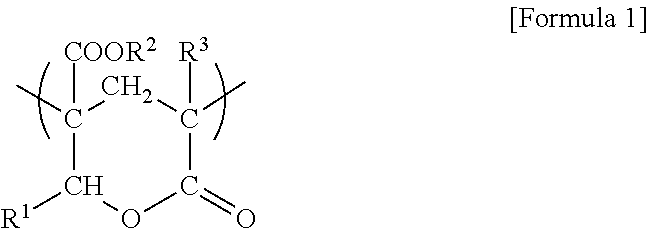Method for producing pressure-sensitive adhesive layer-carrying optical film
a pressure-sensitive adhesive and optical film technology, applied in the direction of film/foil adhesive primer layers, instruments, identification means, etc., can solve the problems of easy lifting or peeling, inability to efficiently perform reworking, and inability to produce a high-quality, high-performance optical film. , to achieve the effect of reducing the stability of the binder resin component, improving adhesion, and reducing the ph
- Summary
- Abstract
- Description
- Claims
- Application Information
AI Technical Summary
Benefits of technology
Problems solved by technology
Method used
Image
Examples
example 1
Preparation of Optical Film (Polarizing Film)
[0128]
[0129]A 75-μm-thick polyvinyl alcohol film with an average degree of polymerization of 2,400 and a degree of saponification of 99.9% by mole was immersed in warm water at 30° C. for 60 seconds so that it was allowed to swell. The film was then immersed in an aqueous solution of 0.3% iodine / potassium iodide (0.5 / 8 in weight ratio) and dyed while stretched to 3.5 times. The film was then stretched to a total stretch ratio of 6 times in an aqueous boric ester solution at 65° C. After the stretching, the film was dried in an oven at 40° C. for 3 minutes to give a PVA-based polarizer (23 μm in thickness).
[0130]
[0131]An 80-μm-thick triacetylcellulose (TAC) film was used as a transparent protective film without being subjected to saponification, corona treatment, and other processes (hereinafter, TAC not having undergone saponification, corona treatment, and other processes is also referred to as “unsaponified TAC”).
[0132]
[0133]The active ...
PUM
| Property | Measurement | Unit |
|---|---|---|
| temperature | aaaaa | aaaaa |
| temperature | aaaaa | aaaaa |
| time | aaaaa | aaaaa |
Abstract
Description
Claims
Application Information
 Login to View More
Login to View More - R&D
- Intellectual Property
- Life Sciences
- Materials
- Tech Scout
- Unparalleled Data Quality
- Higher Quality Content
- 60% Fewer Hallucinations
Browse by: Latest US Patents, China's latest patents, Technical Efficacy Thesaurus, Application Domain, Technology Topic, Popular Technical Reports.
© 2025 PatSnap. All rights reserved.Legal|Privacy policy|Modern Slavery Act Transparency Statement|Sitemap|About US| Contact US: help@patsnap.com

